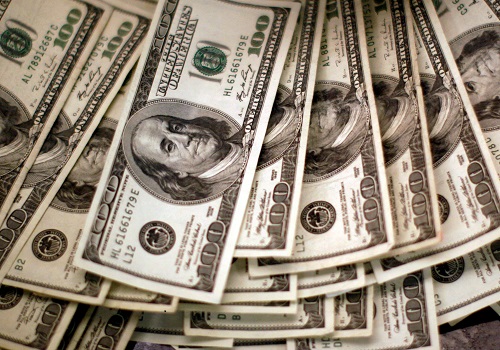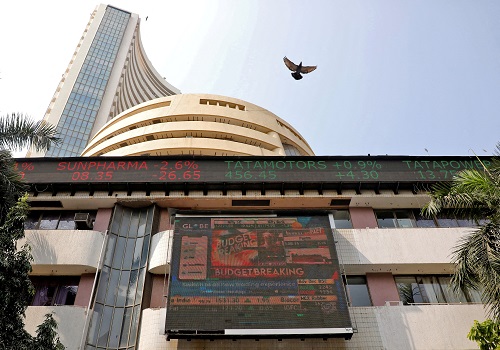Aluminium trading range for the day is 201.3-207.3 - Kedia Advisory

Follow us Now on Telegram ! Get daily 10 - 12 important updates on Business, Finance and Investment. Join our Telegram Channel
Gold
Gold prices saw a modest increase of 0.16%, settling at 62,291, as investors awaited key US inflation data later in the week, influencing the outlook for Federal Reserve monetary policy. New York Federal Reserve President John Williams emphasized that rate cuts were not currently under discussion, and it was premature to speculate about them. Williams highlighted the need for the central bank to be prepared to tighten policy further if progress on inflation were to stall or reverse. Atlanta Fed President Raphael Bostic echoed this sentiment, stating that rate cuts were not imminent, and the first cuts could potentially come in the third quarter of 2024. Global economic dynamics played a role in market sentiment as Germany's flash PMI data indicated a deterioration in business activity, increasing the risk of a recession in the Eurozone's largest economy. Geopolitical events, including North Korea's missile launches, added to the cautious market sentiment. China's state media Xinhua reported favorable economic conditions for 2024, supporting the underlying bullish sentiment in global equity markets and potentially limiting demand for the safe-haven precious metal. Technically, the gold market experienced short-covering, with a drop in open interest by -0.65% to settle at 14,761. Gold is finding support at 62,040, with a potential test of 61,785 on the downside. Resistance is likely at 62,460, and a break above could lead to testing 62,625. The technical overview suggests a cautious market, with investors monitoring economic data and central bank signals for future price direction.
Trading Ideas:
* Gold trading range for the day is 61785-62625.
* Gold prices steadied as investors look forward to key US inflation data due later this week
* Fed’s Williams said that we aren't really talking about rate cuts right now and it's premature to speculate about them.
* The flash PMI prints released showed that business activity in Germany deteriorated during December
Silver
Silver prices saw a marginal decline of -0.15%, settling at 74,410, as markets awaited U.S. inflation data to gauge the Federal Reserve's policy direction following last week's dovish stance. New York Fed President John Williams and Atlanta Fed President Raphael Bostic both indicated that rate cuts were not under consideration in the near term, pushing back against market expectations. Despite this, investors remained confident that the Fed might begin rolling back restrictive monetary policies somewhat earlier. The Eurozone's data showed a deterioration in German business confidence, reinforcing concerns of an economic slowdown highlighted by last week's downbeat PMI figures. Global demand for silver is anticipated to decline by 10% in 2023, with reductions in offtake for silver jewelry and silverware, particularly in India. The global jewelry demand is expected to experience a slight uptick in 2023, while silverware may see a smaller decline of 12%, reflecting setbacks in India. Market expectations include a 70% chance of a Fed rate cut in March, according to the CME FedWatch tool. Traders are now eagerly awaiting U.S. economic data, including the November core personal consumption expenditure (PCE) index report on Friday. Technically, the silver market observed fresh selling, with a gain in open interest by 1.6% to settle at 13,704. Silver is finding support at 74,050, with a potential test of 73,695 on the downside. Resistance is likely at 74,770, and a move above could lead to testing 75,135.
Trading Ideas:
* Silver trading range for the day is 73695-75135.
* Silver steadied as markets awaited U.S. inflation data due this week to ascertain the Federal Reserve's policy path
* Global demand for silver will likely decline 10 per cent in 2023
* Markets are pricing in about a 70% chance of a Fed rate cut in March, according to CME FedWatch tool.
Crude oil
Crude oil prices surged by 2.11%, closing at 6,137, driven by escalating attacks in the Red Sea that prompted oil companies and tanker owners to avoid the region. The market found support from Russian Deputy Prime Minister Alexander Novak's statement, indicating that Russia is contemplating further oil export cuts in December, potentially exceeding 50,000 barrels per day (bpd) to boost global oil prices. These additional cuts would supplement the previously agreed-upon 300,000 bpd reduction for the year. Adverse weather conditions in Russia, leading to the suspension of about two-thirds of loadings from ports, also contributed to the price rally. Geopolitical tensions added to the bullish sentiment as Houthi attacks on ships near Yemen raised concerns about potential disruptions in oil supply. Shipping firms are considering avoiding the Suez Canal as Houthi militants escalate their assaults on commercial vessels in the Red Sea. The International Energy Agency's (IEA) optimistic forecast predicting a 1.1 million bpd increase in oil consumption in 2024 further supported crude oil prices. Additionally, Baker Hughes Rig Counts data on Friday showed a reduction to 501 from the previous count of 503, suggesting slightly decreased consumption of products and services produced by the oil service industry. Technically, the market is under fresh buying, with a gain in open interest by 5.87% to settle at 13,402. Crude oil is currently finding support at 5,940, and a breach below could test 5,744. Resistance is likely at 6,277, with a potential move above leading to testing 6,418.
Trading Ideas:
* Crudeoil trading range for the day is 5744-6418.
* Crude oil gains as rising attacks in the Red Sea led oil companies and tanker owners to steer clear of the region.
* Russian Deputy Prime Minister Alexander Novak said that Russia would deepen oil cuts in December by 50,000 bpd.
* Oil consumption will increase by 1.1 million bpd in 2024 – IEA
Natural gas
Natural gas prices recorded a gain of 1.71%, closing at 214, driven by forecasts projecting higher demand in the upcoming week compared to previous expectations. Despite the backdrop of record gas production and forecasts indicating mild weather in the next two weeks, prices rose as concerns over increased demand for liquefied natural gas (LNG) export plants weighed on the market. The surge in prices was notable given the record gas production and the expectations of lower heating demand due to mild weather in the short term. This trend has prompted some traders to speculate that gas prices may have already peaked for the winter season, particularly in November. Average gas output in the Lower 48 U.S. states increased to 108.5 billion cubic feet per day (bcfd) so far in December, following a record of 108.3 bcfd in November. Despite meteorologists projecting warmer-than-normal conditions through at least December 30, London Stock Exchange Group (LSEG) forecasted a rise in U.S. gas demand in the Lower 48, including exports, from 125.1 bcfd this week to 127.7 bcfd next week. This increase is attributed to the usual seasonal cooling demand at this time of year. Technically, the market is under short covering, with a decrease in open interest by -10.33% to settle at 20,925. Natural gas is currently finding support at 209.2, and a breach below could test 204.4. Resistance is likely at 217.5, and a move above could lead to testing 221. The technical overview suggests a market responding to demand forecasts and export dynamics despite robust production levels and mild weather expectations.
Trading Ideas:
* Naturalgas trading range for the day is 204.4-221.
* Natural gas climbed on forecasts for higher demand next week than previously expected
* That price increase came despite record gas production
* Average gas output in the Lower 48 U.S. states rose to 108.5 bcfd so far in December from a record 108.3 bcfd in November.
Copper
Copper prices experienced a 0.67% decline, closing at 720.8, influenced by China's notable 12.3% YoY surge in refined copper production, reaching 1.14 million metric tons in November. Daily output averaged 38,000 tons. Additionally, Shanghai Futures Exchange-monitored warehouses saw a 13.4% increase in copper inventories from the previous Friday. Concerns over supply shortages contributed to a 25% drop in Chinese spot market copper concentrate processing fees, falling below $70 per metric ton. In September, the global refined copper market showed a 55,000 metric ton deficit, contrasting with the 21,000 metric ton deficit in August, as reported by the International Copper Study Group (ICSG). The first 9 months of 2023 displayed a 17,000 metric ton surplus, deviating from the 401,000 metric ton deficit in the same period the previous year. World refined copper output reached 2.33 million metric tons in September, with consumption at 2.39 million metric tons. Adjusting for changes in Chinese bonded warehouse inventory, a September deficit replaced August's 41,000 metric ton surplus, according to ICSG. Technically, the market witnessed long liquidation, with a 14.95% reduction in open interest to 3568. Prices dropped by -4.85 rupees. Support for Copper is identified at 718.2, potentially testing 715.5 levels, while resistance is expected at 725.5, with a potential move to 730.1 upon breaching this level.
Trading Ideas:
* Copper trading range for the day is 715.5-730.1.
* Copper prices dropped as China's refined copper production in November jumped 12.3%.
* Copper inventories in warehouses monitored by the Shanghai Futures Exchange rose 13.4% from last Friday.
* The global refined copper market showed a 55,000 metric tons deficit in September
Zinc
The recent uptick in Zinc prices, closing at 224 with a 0.36% gain, can be attributed to optimistic Chinese industrial data and expectations of lower U.S. interest rates. China's decision to relax home purchase restrictions in Beijing and Shanghai further fueled positive sentiment, especially amid concerns about the Chinese property sector. Notably, China experienced accelerated industrial output growth of 6.6% YoY in November 2023, surpassing market predictions and showcasing a robust rebound from the previous month. Additionally, the surge in retail sales by 10.1% YoY in November indicates a strong consumer demand, marking the 11th consecutive month of growth and the highest expansion since May. Despite a decrease in refined zinc output by 4.23% MoM in November, the year-on-year increase of 10.62% is noteworthy, albeit slightly below expectations. The decline in domestic zinc alloy output in November, attributed to production halts in Shaanxi, Hunan, and Yunnan, contributed to significant output reductions. Technically, the market witnessed short covering as open interest dropped by -17.91% to 2786, while prices increased by 0.8 rupees. Zinc is currently supported at 222.6, with a potential test of 221.3 levels if this support is breached. On the upside, resistance is likely at 224.9, and a breakthrough could lead to a test of 225.9.
Trading Ideas:
* Zinc trading range for the day is 221.3-225.9.
* Zinc gains on improving Chinese industrial data and hopes for lower U.S. interest rates.
* China's industrial production advanced by 6.6% year-on-year in November 2023
* Also helping improve sentiment about the troubled property sector in China was news that Beijing and Shanghai relaxed home purchase restrictions China
Aluminium
Aluminium exhibited a 1.2% increase, settling at 202.85, fueled by a confluence of supply challenges and resilient demand. Notably, China's robust 34.2% surge in aluminium imports in November, reaching 343,109 metric tons, underscores the nation's strong demand and anticipation of reduced domestic supply. This surge was attributed to both heightened demand and the likelihood of diminished domestic output due to cutbacks in Yunnan province. Yunnan's move to curtail production during its dry season added to supply concerns and prompted increased imports. While November imports slightly dipped from October's peak, the overall trend indicates a 28.3% rise in China's imports of unwrought aluminium and related products for the first 11 months, reaching 2.74 million tons. Conversely, domestic aluminum output in November grew by 4.6% YoY to 3.488 million metric tons, but Yunnan's production cuts resulted in a daily output reduction of 1,185 metric tons to 116,300. The year-to-date output for January-November stood at 37.946 million metric tons, reflecting a 3.6% YoY increase. From a technical standpoint, the market is experiencing short covering, with open interest remaining steady at 2758. Despite this, prices rose by 2.4 rupees. Support for aluminium is identified at 200.5, with a potential downside test to 198.1. On the upside, resistance is anticipated at 205, and a breakthrough could propel prices to 207.1.
Trading Ideas:
* Aluminium trading range for the day is 201.3-207.3.
* Aluminium prices rose supply headwinds and demand support underpinned prices.
* China's Nov aluminium imports rise amid robust demand, concerns over supply
* Authorities in Yunnan, asked producers last month to cut output as the hydropower-dependent region entered its dry season.
Cotton
Cotton prices, represented by "Cottoncandy," settled down by -1.27%, closing at 55940. The decline is attributed to reports of pink bollworm infestation in the cotton crop, causing a reduction in yields. The infestation has decreased from 30.62% during 2017-18 to 10.80% in 2022-23, impacting cotton cultivation across various regions in India. Concerns over pink bollworm infestation have led to a revision of cotton production estimates for the current 2023/2024 season by the Cotton Association of India (CAI). The infestation, along with farmers uprooting plants in Haryana and a significant decline in cotton production by 25% in north Maharashtra due to inadequate rainfall, has contributed to a downward adjustment in production estimates to 29.4 million bales. Global cotton production is expected to outpace consumption for the second consecutive year, with the International Cotton Advisory Committee (ICAC) projecting a 3.25% year-on-year increase in cotton lint production to 25.4 million metric tons in the 2023-2024 season. However, consumption is forecasted to marginally decline to 23.4 million metric tons. Additionally, certified cotton stocks, available for delivery against contracts, dropped to 6,325 bales on December 5th from their highest level in over two years at 87,770 bales on December 1st, according to ICE data. Brazilian cotton shipments increased in November by 12% compared to October but decreased by 5.5% compared to November 2022. Technically, the market is undergoing long liquidation, with open interest remaining unchanged at 191. Cottoncandy is finding support at 55660, with a potential test of 55380 on the downside. Resistance is likely at 56360, and a break above could lead to testing 56780.
Trading Ideas:
* Cottoncandy trading range for the day is 55380-56780.
* Cotton dropped as there are reports infestation of pink bollworm in the cotton crop there has witnessed a decline.
* According to ICE data, certified cotton stocks, dropped to 6,325 bales from their highest level in over two years.
* ICAC projected that global cotton production will likely outpace consumption for the second year in a row.
* In Rajkot, a major spot market, the price ended at 26402.4 Rupees gained by 0.11 percent.
Turmeric
Turmeric prices registered a decline of -2.18%, settling at 14430, driven by slower buying activities in anticipation of stock releases ahead of the commencement of new crops in January 2024. The market also faced pressure due to improved crop conditions attributed to favorable weather conditions. Concerns emerged in Maharashtra over the location of PM Modi's Turmeric Board in Telangana, sparking farmer concerns and impacting market sentiment. Crop conditions are reported to be satisfactory, with harvest expected between January and March. Current levels of buying activity and decreasing supplies are likely to sustain price stability. However, the downside is limited by the potential for yield losses caused by unfavorable weather conditions. Support for prices is evident due to improved export opportunities, with turmeric exports during April-October 2023 rising by 2.63% compared to the same period in 2022. In October 2023, turmeric exports increased by 11.58% compared to September 2023, but saw a 9.30% decline compared to October 2022. Expectations of a 20–25% decline in turmeric seeding this year, particularly in Maharashtra, Tamil Nadu, Andhra Pradesh, and Telangana, contribute to shifting farmer priorities. In Nizamabad, a major spot market, the price of turmeric ended at 13412.9 Rupees, gaining 0.26%. Technically, the market underwent long liquidation, with a -1.05% drop in open interest to settle at 11835. Turmeric is currently finding support at 14284, with a potential test of 14136 on the downside. Resistance is likely at 14706, and a break above could lead to testing 14980.
Trading Ideas:
* Turmeric trading range for the day is 14136-14980.
* Turmeric dropped as buying activities has been slower in expectation of release of stocks ahead of commencement of new crops
* In Sep 2023 around 9,085.81 tonnes exported as against 11,322.58 tonnes in Aug 2023 showing a drop of 19.75%.
* Expectations for a 20–25 percent decline in turmeric seeding this year
* In Nizamabad, a major spot market, the price ended at 13412.9 Rupees gained by 0.26 percent.
Jeera
Jeera prices experienced a significant decline of -5.96%, settling at 37600, driven by expectations of higher production in Gujarat and Rajasthan. The aggressive sowing for Jeera in Gujarat, coupled with sluggish exports, is expected to keep prices under pressure in the near term. Favorable weather conditions have facilitated smooth sowing activities, leading to a substantial increase in the sown area for cumin in both Gujarat and Rajasthan. In Gujarat, cumin sowing witnessed a remarkable growth of nearly 94%, reaching 433,754.00 hectares compared to 224,140.00 hectares in the same period in 2022. Rajasthan also recorded a 13% increase in the area under cumin cultivation, with cumin sown in 6.32 lakh hectares. The global demand for Indian jeera has slumped, with buyers preferring other origins like Syria and Turkey due to comparatively higher prices in India. The export seasonality is expected to keep exports subdued in the upcoming months. Jeera exports during April-October 2023 dropped by 34.02%, reflecting the impact of reduced global demand. In October 2023, jeera exports decreased by 13.39% compared to September 2023 and a significant 46.77% compared to October 2022. In Unjha, a major spot market, the price of jeera ended at 39313.05 Rupees, gaining 1.01%. Technically, the market witnessed long liquidation, with a -4.42% drop in open interest to settle at 3117. Jeera is currently finding support at 36660, with a potential test of 35720 on the downside. Resistance is likely at 39470, and a break above could lead to testing 41340.
Trading Ideas:
* Jeera trading range for the day is 35720-41340.
* Jeera dropped due to higher production prospects in Gujarat and Rajasthan.
* An increase in sowing of about 13 percent has been recorded in the area of cumin in Rajasthan.
* Stockists are showing interest in buying on recent downfall in prices triggering short covering.
* In Unjha, a major spot market, the price ended at 39313.05 Rupees gained by 1.01 percent.



















